what might offred be referring to when she states, "girls dressed for easter, in rabbit suits"
'I don't desire to be a dancer, my feet in the air, my head a faceless oblong of white fabric. I don't want to be a doll hung upwards on the Wall, I don't want to be a wingless affections. I desire to go along on living, in any course. I resign my body freely, to the uses of others.'
In Margaret Atwood'due south The Handmaid's Tale, when Offred and Ofglen laissez passer the Wall where the bodies of murdered women hang 'similar dead butterflies' – alongside the homosexuals executed for 'gender treachery' and the doctors with signs of foetuses hanging around their necks, killed for carrying out abortions or prescribing contraception – Ofglen remarks, "Let that exist a reminder to us". Does she mean that the expressionless traitors should serve as a warning of the need for obedience, or of the imperative for underground rebellion? The ghastly image seems to emphasise the futility of death, but is the 'life at all costs' that Offred chooses whatever ameliorate?
The chilling image which opens Annilese Miskimmon'south new production of Poul Ruders's The Handmaid's Tale at English National Opera aptly reminds us of these ambiguities. To a higher place the bare Coliseum stage, a haunting ensemble of handmaids' habits is suspended – fragile, ruby (symbolic of fertility and expiry), and empty, the women'south identities wiped out past Gilead, though, as Offred herself muses, while the bags over their heads make them 'a cypher', if you look hard enough their facial features seem to linger beneath.
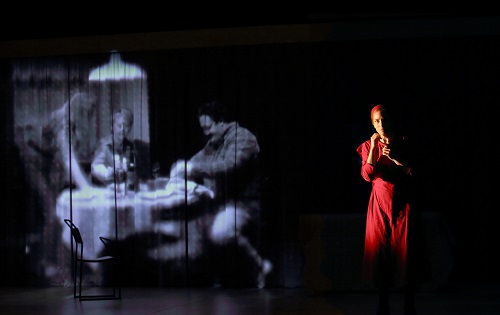
Annemarie Woods's minimalist designs emphasise both this anonymity and the whispering that cannot be entirely expunged past the tyranny and torture of Gilead'southward patriarchal regime, though the Wall itself seems more than a memorial monument than persuasive propaganda to encourage self-regulation. Alpine perimeter curtains make a prison of the Coliseum stage and confirm the claustrophobia of this autocratic globe. A foreshortening half-drape is dropped mid-stage to intensify the scenes of intimacy. It also serves as a screen for Akhila Krishnan's monochrome video projections which offer a flickering montage of the Time Earlier – the years of Offred's mother's second-moving ridge feminism, Offred's own married life and motherhood – helpfully enhancing our awareness of the memories of the past and how things have changed that persistently torment Offred in the novel, an aspect of her ironic, analytical, self-critical narrative that evidences her growing political awareness and which is necessarily simplified in the opera libretto.
The black-and-white flick too contextualises one of the opera's almost powerful structural features: the painful replaying in Offred's mind of the moment when her 5-year-old daughter was snatched and her husband shot. Broken-hearted that her memory of Luke will fade, in the novel Offred describes her mental images as being mirages, 'flickering similar the images of saints'. The harrowing dramatic enactment of the narrative's circular interiority is brilliantly done in Miskimmon's production, the moment of separation heightened past the sudden violent surge of rising orchestral sound. Portuguese conductor Joana Carneiro shapes such musico-psychological realism brilliantly and throughout draws wonderfully vivid playing from the ENO musicians, the eclectic score driving forward with incessant dynamism.
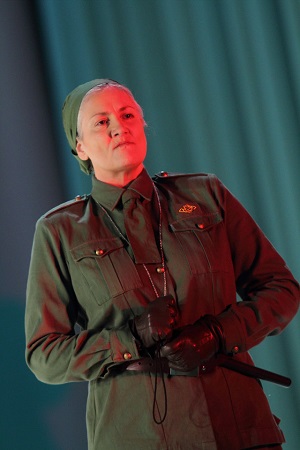
The meeting between Offred and her Double is similarly powerful and affecting, and, every bit the sung stichomythia builds in rhythmic intensity until the two song lines are overlayed, information technology both dramatises and allows usa to enter the protagonist's interiority. Kate Lindsey, who gives a stunning performance as Offred, seems to have pre-recorded the part of Offred's past self and, seemingly glimpsed behind the picture screen, the latter is a disturbing, liminal figure, simultaneously real and unreal. Offred's retentiveness of her daughter, 'Sometimes she'due south holding her one-eyed blue rabbit', is both sweet and painful, accompanied by a soaring solo violin. Just equally tangible is Offred'due south moment of imagined tender interaction with her daughter, with immature Elspeth Macdonald threatening to become the star of the show.
Atwood'south novel plunges the reader immediately into another world. The opening scene is set in what was previously a gymnasium and is now a sleeping area in a women'southward centre overseen past bearding Aunts who enforce the oppressive regulations with electrical cattle-prods. The narrative presents a litany of change and loss, of 'what had one time been'. Information technology is not until the end of the novel that a structural shift reveals that the world, and consciousness, that nosotros have inhabited for well-nigh three hundred pages is itself 'the by', and that what we have read is actually a transcript by i Professor Pieixoto which he has delivered at the Briefing on Gileadean Studies about two hundred years later. Paul Bentley's libretto employs a framing device which sacrifices the disconcerting irony and reshaping of the reader's relationship to the subjective narrative that the novel'south epilogue, 'Historical Notes', achieves. A banner spans the stage: 'International Historical Association Convention, 20-25 June 2195, 12th Symposium on the Republic of Gilead (Formerly the Us of America)'. The opera audition effectively become attendees at that academic conference, assembled to watch the tapes that Professor Pieixoto has discovered.
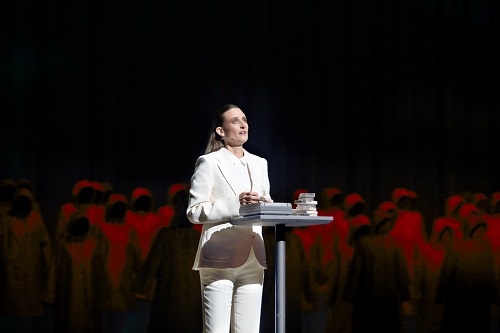
Given that opera must show rather than tell, it's a convincing theatrical device, admitting 1 that shifts the emphasis from the personal to the communal. But, there's a imitation note in Miskimmon'due south production, for French actress Camille Cottin is cast every bit the white-suited Professor Pieixoto, eradicating the irony of Atwood'southward novel in which the male Professor – whose Keynote Accost is littered with misogynistic 'jokes' – arrogantly appropriates Offred's voice and denies her identity by, in a parody of Gilead itself, editing his transcripts into a 'coherent' narrative and naming information technology 'The Handmaid's Tale'.
The fictional Offred tin can be problematic for a reader, seeming passive at times, knowingly unreliable equally a narrator with a penchant for linguistic games and give-and-take play. In the opera, though, while nosotros are more distanced from Offred's interior consciousness, we are more physically involved in her experience, and American mezzo-soprano Kate Lindsey – making her ENO debut in what may well turn out to be a career-defining performance – gives an astonishingly visceral functioning of enormous emotional impact. But, if the sheer brutality and horror of Offred's experience is laid bare, Lindsey also capture the poignancy of the quieter, introspective moments, as when, in the doctor'southward office, Offred's feelings most her inability to conceive the Commander'south kid, "Every moon I watch for blood, and every moon blood appears, dark tears of failure", are revealed. Lindsey's song control and stamina are stunning: we feel every ounce of Offred's desolation but also sense her ultimate denial of Gilead's conclusion to destroy her spirit.
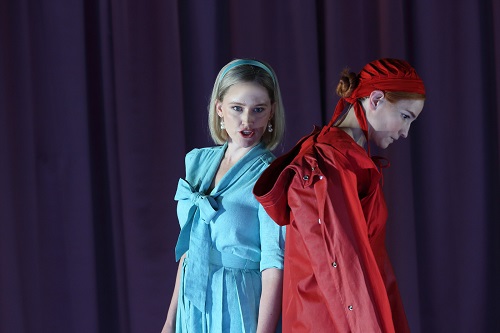
American contralto Avery Amereau is similarly superb as the Commander's Married woman, Serena Joy, her dark phonation possessive and dismissive, her pale-blue Alice-ring ironically connoting the Virgin Mary and also reflecting her frigidity and frozen emotions. The Aunts are led by Emma Bong's ferocious Aunt Lydia, whose stratospheric coloratura vocal line is equally piercing and taut as a steel wire simply who, when joining in the singing of hymns, ironically proves capable of sweet sincerity. Bell whips up a terrifying tension, viciously relishing her control and seeming to believe her own mantra that by freedoms were in fact anarchy, that 'freedom to' has been replaced by freedom 'from'. Indeed, at times she seems to convince the handmaidens likewise that they are protected past restriction, equally in the brutal Particicution scene when the latter trounce to death a Guardian accused of rape.
The plush brightness of Pumeza Matshikiza's soprano captures Moira's subversiveness and energy, confirming her refusal to submit and be macerated. Offred'due south mother'south feminist activism and credo – and Offred's uncomfortable response to them – are diminished in the opera, but Susan Bickley makes much of the cameo role. Janine/Ofwarren is a more sympathetic figure in the opera, and Rhian Lois conveys her disintegration, from prideful pregnancy to mental dissolution upon the death of her baby, with distressing credibility. Elin Pritchard makes Ofglen, Offred's walking companion, a figure of integrity and forbearance.
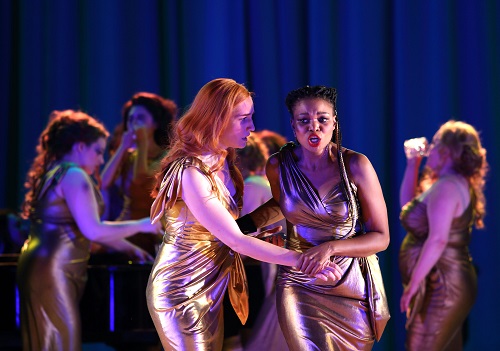
British bass-baritone Robert Hayward'due south Commander is an appropriately elusive effigy, controlling and confident, however strangely weak. When he commands Offred to put on a slinky golden lame gown and stilettos and accompany him on an illicit visit to the brothel, Jezebel'due south, his desire makes him ludicrous even as information technology renders him man. The Scrabble game they play, though, which Offred both finds herself genuinely enjoying and uses to manipulate the Commander, is too brief in the opera to make its mark. And, the sparseness of Woods's designs deprive the opera of some of the novel's symbolism. Just as there is no flower garden for Serena Joy to tend, in the absence of a child to enhance, the Commander's part lacks the element that so startles Offred in Atwood's novel: "Books and books and books, correct out in manifestly view, no locks, no boxes. No wonder we can't come in here. It'southward an oasis of the forbidden."
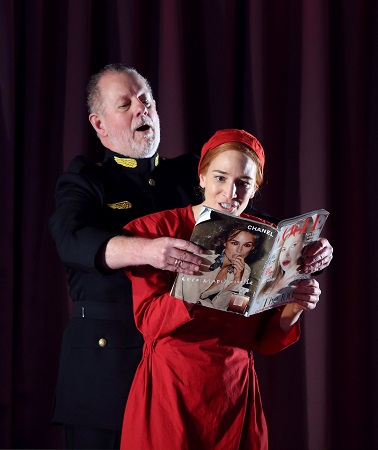
The opera inevitably has to forgo the self-cogitating assay of Atwood's narrative, in which almost every sentence demands probing estimation, and 1 effect of this is that the characterisation is simplified. But, the male members of the cast brand the nigh of their brief appearances. Tenor John Findon makes Luke's sudden realisation that masculine privilege would non enable him to go along his daughter and married woman rubber persuasively tense and vulnerable. Frederick Ballantyne is engaging as Nick, Guardian to the household and chauffeur to the Commander, and Alan Oke oozes sleaze and slime as the lewd doc who offers to impregnate Offred. The Handmaids sing their unison choruses with focus and clarity, their chant-like quality farther foregrounded past the score'south intertextual integration of hymn tunes and chorales, which enable Ruders to expose religious hypocrisies.
Margaret Atwood conceived the Republic of Gilead equally a logical result of what she described equally the 'strict theocracy' of the 'fundamentalist government' of the U.s.a.' Puritan founding fathers, arguing that 'Countries continue the way they began; they rearrange the symbols and structures only something remains of their origins'. She noted, for case, that Ronald Reagan had a penchant for the early Puritans' biblical maxims, referring to the US equally 'a light to all nations'. But, in the 1980s it was common to equate Gilead with theocracies such as Iran; since then – every bit the novel has been absorbed into the school curriculum and made into a television series – it's ofttimes suggested that contemporary political and social concerns – the rise of the Taliban, unfettered access to online pornography, misogynistic corruption on social media – has made the novel even more relevant today. In the American Library Association's list of Tiptop 100 Almost Banned and Challenged Books for the decade from 2010 to 2019, Margaret Atwood'southward The Handmaid's Tale sits at number 29.
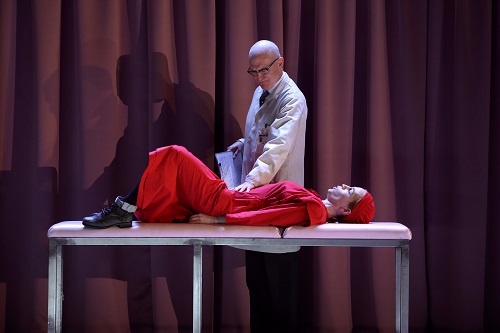
Offred looks back at 'what was in one case' and wishes to have 'everything back, the mode information technology was' something which the opera's alternations between the Time Now, which Bentley has described as 'the sour present', and the Time Before, 'the sweetness past', might seem to endorse. Simply, Atwood doesn't suggest that the by was a utopia. She depicts a world where women were free simply had internalised the cognition that they weren't safety; where pornography was ubiquitous; where women were found 'in ditches or forests or refrigerators in abandoned rented rooms, with their clothes on or off, sexually driveling or not; at whatever rate killed'.
The novel has iii epigraphs. The first, from Genesis, confirms the novel'south gender politics. The second, from Swift, intimates that societies volition countenance horrific principles that are counter to man'south very humanity. Atwood has explained the third, 'In the desert, there is no sign that says Thou shalt not eat stones', as 'stating a uncomplicated human truth: we don't prohibit things that nobody would ever want to do anyhow, since all prohibitions are founded upon a denial of our desires'. The Handmaid'south Tale may show what happens when nosotros prohibit natural man desires, just it too encourages us to enquire whether the freedom to savour those desires is worth the cost we may have to pay. Ruders'southward opera largely eschews this question. Just, Miskimmon'south production makes the questions that the opera does inquire of the states pressing and discomforting.
Claire Seymour
Offred – Kate Lindsey, Aunt Lydia – Emma Bell, The Commander – Robert Hayward, Serena Joy – Avery Amereau, Nick – Frederick Ballentine, Janine/Ofwarren – Rhian Lois, Moira – Pumeza Matshikiza, Ofglen – Elin Pritchard, Rita – Madeleine Shaw, The Doctor – Alan Oke, Offred's Mother – Susan Bickley, Luke – John Findon, New Ofglen – Annabella Vesela Ellis, Professor Pieixoto – Camille Cottin; Director – Annilese Miskimmon, Conductor – Joana Carneiro, Designer – Annemarie Woods, Lighting designer – Paule Constable, Video designer – Akhila Krishnan, Sound designer – Yvonne Gilbert, Movement manager – Imogen Knight.
English National Opera, London Coliseum; Friday 8th April 2022.
Source: https://operatoday.com/2022/04/the-handmaids-tale-at-english-national-opera/
0 Response to "what might offred be referring to when she states, "girls dressed for easter, in rabbit suits""
Post a Comment